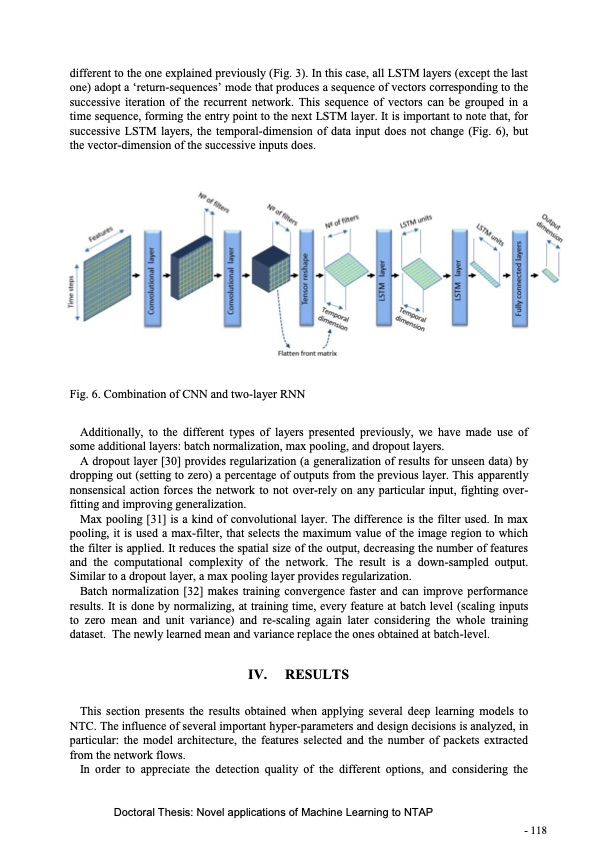
PDF Publication Title:
Text from PDF Page: 120
different to the one explained previously (Fig. 3). In this case, all LSTM layers (except the last one) adopt a ‘return-sequences’ mode that produces a sequence of vectors corresponding to the successive iteration of the recurrent network. This sequence of vectors can be grouped in a time sequence, forming the entry point to the next LSTM layer. It is important to note that, for successive LSTM layers, the temporal-dimension of data input does not change (Fig. 6), but the vector-dimension of the successive inputs does. Fig. 6. Combination of CNN and two-layer RNN Additionally, to the different types of layers presented previously, we have made use of some additional layers: batch normalization, max pooling, and dropout layers. A dropout layer [30] provides regularization (a generalization of results for unseen data) by dropping out (setting to zero) a percentage of outputs from the previous layer. This apparently nonsensical action forces the network to not over-rely on any particular input, fighting over- fitting and improving generalization. Max pooling [31] is a kind of convolutional layer. The difference is the filter used. In max pooling, it is used a max-filter, that selects the maximum value of the image region to which the filter is applied. It reduces the spatial size of the output, decreasing the number of features and the computational complexity of the network. The result is a down-sampled output. Similar to a dropout layer, a max pooling layer provides regularization. Batch normalization [32] makes training convergence faster and can improve performance results. It is done by normalizing, at training time, every feature at batch level (scaling inputs to zero mean and unit variance) and re-scaling again later considering the whole training dataset. The newly learned mean and variance replace the ones obtained at batch-level. IV. RESULTS This section presents the results obtained when applying several deep learning models to NTC. The influence of several important hyper-parameters and design decisions is analyzed, in particular: the model architecture, the features selected and the number of packets extracted from the network flows. In order to appreciate the detection quality of the different options, and considering the Doctoral Thesis: Novel applications of Machine Learning to NTAP - 118PDF Image | Novel applications of Machine Learning to Network Traffic Analysis

PDF Search Title:
Novel applications of Machine Learning to Network Traffic AnalysisOriginal File Name Searched:
456453_1175348.pdfDIY PDF Search: Google It | Yahoo | Bing
Cruise Ship Reviews | Luxury Resort | Jet | Yacht | and Travel Tech More Info
Cruising Review Topics and Articles More Info
Software based on Filemaker for the travel industry More Info
The Burgenstock Resort: Reviews on CruisingReview website... More Info
Resort Reviews: World Class resorts... More Info
The Riffelalp Resort: Reviews on CruisingReview website... More Info
| CONTACT TEL: 608-238-6001 Email: greg@cruisingreview.com | RSS | AMP |